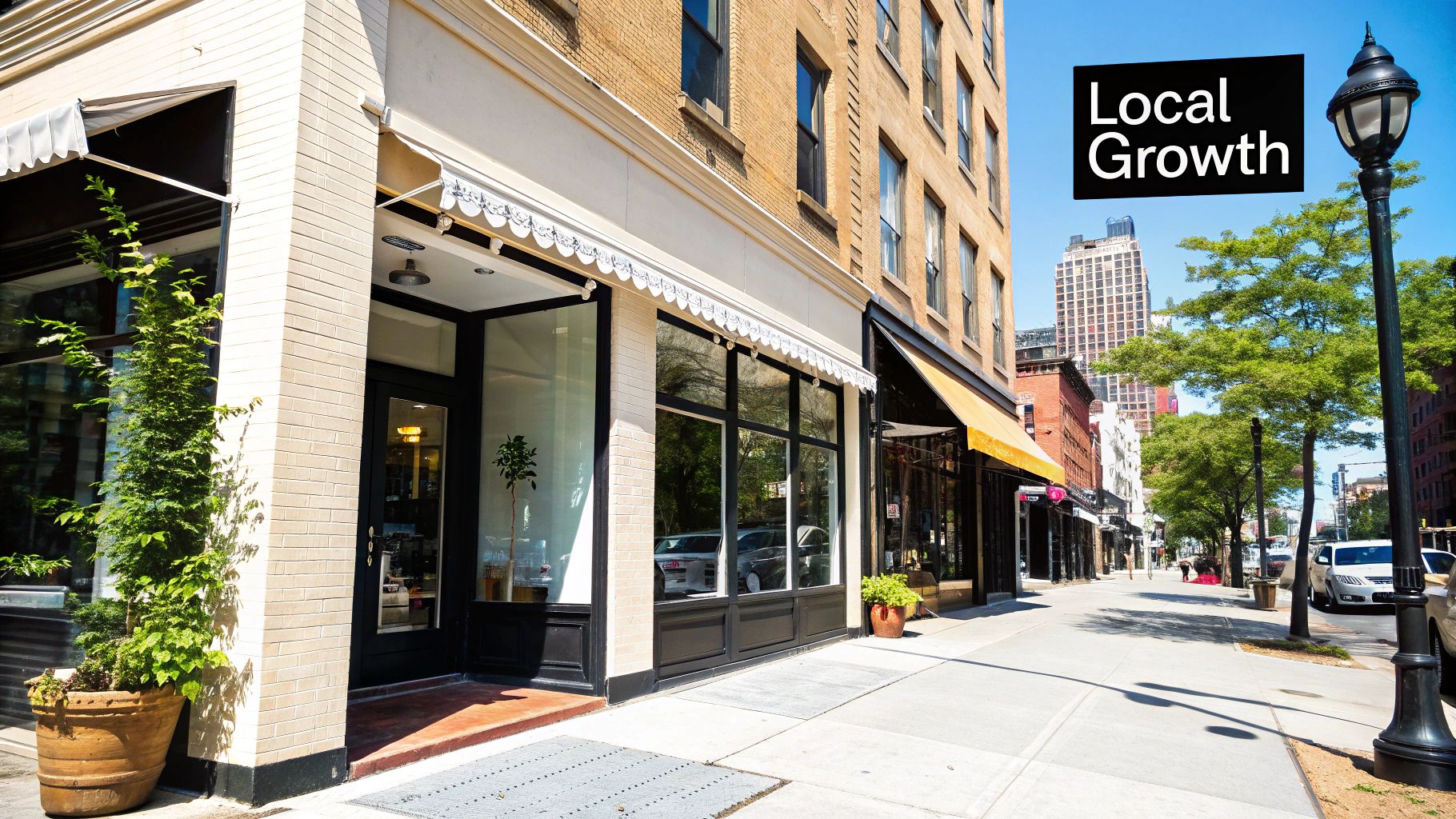The Digital Revolution in Local Business Marketing

The local business world is changing. Relying only on word-of-mouth and print ads just isn't enough anymore. A strong online presence is now crucial for local businesses to succeed. This means adapting to how customers are now finding and interacting with businesses.
Why Digital Matters for Local Businesses
This move to digital is a major shift in how consumers connect with local businesses. Think about it – how often do you search online for a nearby restaurant, salon, or plumber? Customers expect to find businesses online, check out what they offer, and often decide what they want before even visiting a physical location. Many businesses are now found through online searches like Google instead of traditional phone books.
This change has given local businesses new tools. They can target specific customer groups more effectively, see how well their marketing is working, and build better relationships with customers through online interaction. Digital marketing also reaches more people and is often more affordable than traditional methods. However, many local businesses are still figuring out how to adjust.
This digital shift for local businesses has been a major trend. 63% of small businesses have moved to or improved their digital operations in the last year. This has significantly increased their online revenue, with 65% of businesses reporting higher digital earnings compared to before the pandemic. For more detailed stats, check out this resource: Local Business Statistics.
Embracing Digital While Staying Local
Succeeding in this digital world means blending traditional and digital marketing strategically. Local businesses shouldn't lose their local touch. They should strengthen it with a smart digital strategy. This means understanding your target audience's online habits and adapting your digital marketing accordingly.
Evaluating Your Current Marketing Mix
A crucial first step is to assess your current marketing efforts. Ask yourself these questions:
- Where do my customers find me now?
- Which digital channels am I using well?
- What opportunities am I missing?
By honestly reviewing your current strategy, you can pinpoint the best digital opportunities for your business. This might involve improving your Google Business Profile, using local SEO strategies, or connecting with your community on social media. The goal is to create a smooth online-to-offline experience that brings in new customers and keeps current ones coming back.
Social Media That Actually Drives Local Traffic
Social media offers incredible potential for local businesses. It's not just about vanity metrics; it's a powerful tool for connecting with your community and driving tangible results. But turning followers into customers requires a strategic approach. You need to understand which platforms best suit your business and tailor your content to resonate with your local audience.
Choosing the Right Platforms for Your Business
Different social media platforms cater to different audiences and content formats. What works for one business might not work for another. Facebook remains a strong choice for reaching a wide audience and using location-based targeting. Instagram, with its visual nature, is ideal for showcasing products and services, especially for businesses like restaurants and retailers. Nextdoor focuses on hyperlocal connections, making it perfect for reaching customers in your immediate area.
To help you decide, let's look at a comparison of these platforms:
To help you choose the best platform for your local business, take a look at this comparison:
Social Media Platform Effectiveness for Local Businesses
Comparison of different social media platforms and their effectiveness for local business marketing based on audience demographics and engagement metrics
| Platform | Best For | Primary Audience | Content Format | Average Engagement Rate |
|---|---|---|---|---|
| Reaching a broad audience, targeted advertising | Varies widely, allows for granular targeting | Text, images, videos, live streams | 0.09% (Source: Rival IQ) | |
| Visual storytelling, showcasing products and services | Younger demographics, visually-driven users | High-quality images and videos, stories, reels | 0.98% (Source: Rival IQ) | |
| Nextdoor | Hyperlocal connections, community engagement | Residents within specific neighborhoods | Text, images, recommendations, local events | Varies, typically higher than other platforms due to community focus |
Average engagement rates can vary based on industry, content quality, and audience size. This table provides a general benchmark.
Choosing the right platform is the first step. You also need to tailor your approach to each platform. For example, on Facebook, use targeted advertising to reach specific demographics within your service area and engage with local community groups. On Instagram, leverage high-quality visuals and location tags. On Nextdoor, participate in local conversations and offer exclusive deals.
Creating Content That Connects With Your Community
Effective social media marketing hinges on creating content that truly resonates with your target audience. Go beyond generic posts and create content that speaks directly to your local community's needs and interests. Share local news, highlight community events, and showcase customer testimonials.
For instance, a local bakery could share recipes using seasonal ingredients, partner with other local businesses for cross-promotions, or feature customer photos of their treats.
This localized content builds trust and authenticity. Remember, social media is a core part of small business promotion. A significant 96% of small business owners utilize social media for marketing, mainly choosing platforms like Facebook and Instagram. What's more, 55% of consumers discover new brands through social media. Find more detailed statistics here.
Measuring Social Media ROI for Local Businesses
Tracking your social media efforts is essential. While likes and shares offer some insights, focus on metrics that have real-world impact: website clicks, online orders, in-store visits, and phone calls. Use analytics tools to track the customer journey from social media to your website or physical location. By understanding how customers interact with your content and how that translates into conversions, you can refine your strategy and maximize your ROI.
Dominating Local Search Without Technical Headaches

Getting your local business noticed online starts with a strong presence in local search results. You don't need to be a tech whiz to achieve this. There are plenty of straightforward strategies you can use to attract more customers in your area.
Optimizing Your Google Business Profile
Your Google Business Profile (GBP) is the online equivalent of your shop window. It’s often the first thing potential customers see when they search for businesses like yours. A complete and accurate GBP listing is crucial for local search visibility. This includes correct business details, appealing photos, and regular updates.
Make sure your opening hours are always current, especially around holidays. Showcase your offerings with high-quality photos of your products, services, and the overall atmosphere of your business. Encourage satisfied customers to leave reviews. Positive reviews not only improve your search ranking, but also build trust with potential customers.
Targeting Valuable Local Keywords
Keywords are the building blocks of search engine optimization (SEO). Understanding what your customers search for is key to successful local business marketing. Put yourself in their shoes. What terms would they use to find the products or services you offer? Be sure to include location-based keywords like "bakery in San Francisco" or "plumber near me."
Also, check out your competitors' keywords. You might uncover opportunities they've overlooked. Tools like Google Keyword Planner can help you discover relevant local keywords and see how often people search for them.
Creating Location-Specific Content
Go beyond your GBP and create content that resonates with your local community. Blog posts, articles, and social media updates can all be tailored to local interests. Consider highlighting community events, featuring local partnerships, or sharing stories about how your business is involved in the area.
This locally focused content strengthens your connection with your audience and improves your local search ranking. A well-defined social media presence is essential for local businesses. Review your social media strategy for small business to maximize local engagement. Local search has a big impact. Roughly 80% of consumers use search engines to find local information, and 46% of all Google searches are locally focused. With mobile traffic accounting for 63.38% of global web traffic, a mobile-friendly website is a necessity. For more statistics, check out these Small Business Marketing Statistics.
Understanding Mobile Search Behavior
Given how many people search on their phones, optimizing your website for mobile devices is paramount. Your site should be responsive, adapting smoothly to different screen sizes. Think about how people use their phones to search—often, they need quick access to key information like your address, phone number, and hours. Make this information easy to find.
Mobile users frequently use location services. Optimizing your GBP and listing your business in local directories ensures you show up in location-based searches. By understanding and catering to mobile search behavior, you can effectively reach a significant portion of your local target market.
Email Marketing That Keeps Local Customers Coming Back
Email marketing remains a powerful tool for local businesses. It's not just about sending newsletters; it's about building relationships and encouraging repeat business. This means understanding your local customer base and creating targeted email campaigns that connect with their needs and interests.
Building Your Email List
A strong email list is the foundation of successful email marketing. Offer incentives for customers to sign up.
- Exclusive discounts
- Early access to sales
- Valuable local content like neighborhood guides or event calendars
Place signup forms strategically in your physical location, on your website, and through social media channels.
Consider partnering with other local businesses for cross-promotional opportunities. This expands your reach and allows you to connect with new audiences within your community.
Segmenting Your Audience for Targeted Messaging
Generic emails rarely work. Segmentation allows you to divide your email list into smaller groups based on factors like demographics, purchase history, or engagement level. This lets you personalize your messaging and send relevant content to different segments.
For example, a local bookstore could segment its list into fiction lovers, non-fiction enthusiasts, and children's book readers. Each segment would receive targeted email recommendations and promotions tailored to their interests.
Crafting Engaging Content That Provides Value
Your email content should be valuable and relevant to your audience.
- Offer exclusive deals
- Share insider tips
- Highlight upcoming local events
- Showcase customer stories and testimonials to build social proof
Think about connecting your email content to seasonal events and local happenings. A restaurant could promote special menus for local festivals or offer discounts during community events.
Measuring the Impact of Your Email Campaigns
Tracking your email marketing success is crucial for improvement. Monitor key metrics:
- Open rates: The number of people opening your emails.
- Click-through rates: The number of people clicking on links within your emails.
- Conversion rates: The number of people taking the desired action, like visiting your website or making a purchase.
Use this data to understand what resonates with your audience and refine your messaging. Consistently analyzing and adapting your email strategies based on these insights helps build stronger relationships with your local customer base and drives repeat business.
Building a Local Content Strategy That Actually Connects

Content marketing offers real advantages for local businesses. It's about more than just putting content out there; it's about building relationships within your community and highlighting your expertise. This means understanding your target audience, creating relevant material, and selecting the right formats for maximum impact.
Understanding Your Local Audience
Before you start creating, take the time to know your local audience. What interests them? What do they need? What problems are they facing? Local market research can offer valuable information. This could involve surveys, focus groups, or even just observing local conversations on platforms like Facebook or Instagram. Understanding your audience lets you create content that resonates and tackles their specific concerns.
Crafting Locally Relevant Content
Your content should speak directly to your community. For example, a local bakery could share recipes using local ingredients, promote community events, or feature stories about the local farmers they work with. A hardware store might create how-to videos addressing common home repair issues specific to the area. This shows your commitment to the community and positions you as an expert.
Showcasing Customer Success Stories
Customer testimonials are powerful tools in local business marketing. Encourage happy customers to share their experiences. These stories build trust and offer social proof. Feature these testimonials on your website, social media, and even in email newsletters. Keep them authentic and highlight the specific benefits your business provided.
Choosing the Right Content Formats
Different content formats suit different audiences and businesses. Short, engaging videos are great for showcasing products or services, while blog posts allow you to share in-depth knowledge. Podcasts offer a more personal way to connect with your community.
Here's a breakdown of some effective formats:
-
Behind-the-Scenes Videos: Give your audience a peek into your operations and introduce your team. This creates transparency and humanizes your brand.
-
Community-Focused Podcasts: Interview local figures or discuss community issues. This positions your business as a valuable local resource.
-
Blog Posts Featuring Local Knowledge: Share insightful content about local events, attractions, or history. This further cements your business as a go-to resource for the community.
To help you choose the best formats for your business, check out the table below:
To help you choose the best formats, the table below provides a general overview of different content marketing ROI based on format:
Local Content Marketing ROI by Format
Data on different content formats and their effectiveness for local businesses based on engagement, conversion rates, and resource requirements
| Content Format | Average Time Investment | Customer Engagement Rate | Lead Generation Effectiveness | Best For |
|---|---|---|---|---|
| Blog Posts | High | Medium | Medium | Sharing in-depth information, building authority |
| Videos | Medium | High | High | Showcasing products/services, building brand personality |
| Podcasts | High | Medium | Medium | Building community, establishing thought leadership |
| Social Media Posts | Low | Medium | Low | Building brand awareness, driving traffic to other content |
| Email Newsletters | Medium | Medium | High | Promoting offers, nurturing leads, building customer loyalty |
This table provides a general overview. Actual results may vary based on industry and specific content quality.
Measuring Content Effectiveness
Tracking your local content strategy’s success is essential. Focus on metrics that tie into your local business goals, such as website traffic from local searches, in-store visits, and online conversions. Utilize analytics tools like Google Analytics to measure your content’s reach, engagement, and impact on customer behavior. Regularly review these metrics to refine your strategy and ensure your content continues to connect with your local audience. This data-driven approach maximizes your return on investment and helps you adapt to changes in the local market.
Turning Customer Reviews Into Your Strongest Marketing Asset
Customer reviews hold significant power in shaping a local business's trajectory. They can elevate your reputation or, conversely, inflict damage. Many business owners simply react to reviews, but a strategic approach involves proactively managing and leveraging them to influence customer decisions.
Generating Positive Reviews
The first step involves encouraging satisfied customers to share their positive experiences. Don't hesitate to ask for reviews! Train your staff to identify happy customers and suggest they leave a review on platforms like Google, Yelp, or industry-specific sites. Streamline the process by providing a QR code that directs customers straight to your review page.
Offering incentives can be a delicate matter. A small token of appreciation is generally acceptable, but avoid offering substantial rewards, which can be perceived as buying reviews and ultimately harm your credibility.
Responding to Reviews, Both Good and Bad
Responding to reviews demonstrates that you value customer feedback. Thank customers for positive reviews and address negative reviews constructively. A well-crafted response to a negative review can transform a dissatisfied customer into a loyal advocate. It also signals to potential customers that you prioritize their experience.
For instance, if a customer complains about slow service, acknowledge their experience, apologize, and outline the steps you're taking to improve. This shows a genuine commitment to customer satisfaction.
Leveraging Positive Reviews Across Marketing Channels
Don't let positive reviews languish on review platforms. Share them on your website, social media channels, and even in email marketing campaigns. Positive reviews cultivate trust and encourage potential customers to choose your business over competitors.
Consider creating visually appealing graphics featuring positive reviews. You can also incorporate snippets of positive reviews into your local advertising campaigns to boost their impact.
Platform-Specific Strategies
Different platforms have different audiences and guidelines. Google reviews are essential for local search visibility. Yelp is a popular platform for restaurant and service-based businesses. Industry-specific review sites can be especially valuable for niche businesses. Adapt your approach to each platform's unique characteristics.
For example, on Google, encourage customers to upload photos and videos along with their reviews. On Yelp, actively engage with the Yelp community and respond to reviews promptly.
Monitoring Your Online Reputation
Tracking your online reputation is an ongoing endeavor. Use tools like Google Alerts to monitor mentions of your business online. This enables you to address issues swiftly and stay informed about customer sentiment. While monitoring is essential, avoid fixating on every single review. Concentrate on overall trends and use the feedback to continuously improve your business. By strategically managing and utilizing customer reviews, you can transform them into a powerful marketing asset for your local business.
Measuring What Actually Matters in Local Marketing

Many local businesses track metrics that don't reflect their true success. Instead of focusing on vanity metrics, concentrate on what genuinely impacts your bottom line. This means identifying Key Performance Indicators (KPIs) that align with your business goals and local market.
Establishing Meaningful KPIs
First, define what success means for your business. Is it increased foot traffic? More online orders? A higher volume of phone calls? Perhaps it's a combination of these factors. Your KPIs should directly reflect these core objectives.
For example, a restaurant might prioritize reservations and online orders. A retail store might focus on in-store visits and sales transactions. A service-based business, like a plumber, might track phone calls and booked appointments. Defining your goals helps you select the right KPIs.
Tracking Cross-Channel Performance
Local business marketing often spans multiple channels. These can include social media, email marketing, local search optimization, and online advertising. Tracking performance across these channels is essential to understanding their effectiveness.
Google Analytics can help monitor website traffic, conversions, and customer behavior. Social media platforms provide insights into engagement and reach. Focus on metrics that directly contribute to your goals to avoid data overload.
Regular Measurement Review and Resource Allocation
Regularly review your KPIs to optimize your marketing efforts. This involves analyzing your data, identifying trends, and adjusting your strategy accordingly.
For example, a spike in website traffic from a specific social media campaign might suggest allocating more resources to that channel. If email marketing isn't generating conversions, you might need to revise your messaging or your audience segmentation. This iterative process ensures your marketing efforts drive meaningful growth.
Frameworks for Identifying High-ROI Activities
Clear frameworks help you pinpoint high-ROI marketing activities. This means analyzing the cost of each activity and comparing it to the generated revenue.
For instance, a local advertising campaign costing $500 that results in $2,000 in sales demonstrates a strong ROI. However, a social media campaign costing $200 that only generates $100 in sales might require reevaluation. Focus on high-return activities to maximize your marketing budget and achieve sustainable business growth. This data-driven approach allows for informed resource allocation and ensures your marketing contributes to your bottom line. Continuously improving your strategy is key to long-term success in local business marketing.
Are you ready to elevate your creative projects? Connect with top local talent on Creativize and bring your vision to life.

